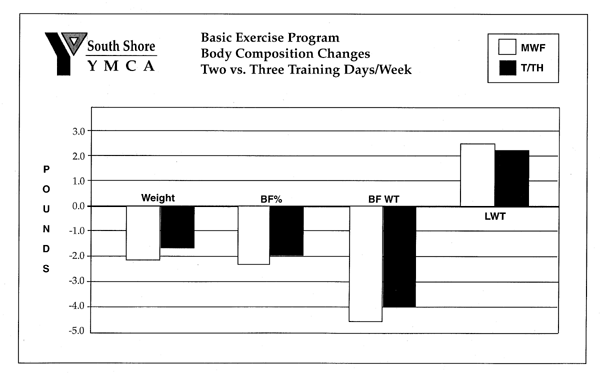Another research finding is that the younger (ages 21-40), middle (ages 41-60), and older (ages 61-80) adults, all attained similar improvements in body composition and resting blood pressure. Just as important, those who began the program in the poorest shape (highest percent fat) experienced the most fat loss and lean (muscle) gain. That is, the adults who had the greatest fitness needs made the greatest improvements.
A practical reason for the success of the basic exercise program is the time-efficient training requirements. The participants did only 25 minutes of strength exercise and 25 minutes of aerobic activity each training session. Even more helpful for many time-pressured adults, only two workouts a week were necessary for excellent results. As shown in Figure 1, the two-day and three-day exercisers made similar improvements in body composition and resting blood pressure after eight weeks of training.

Changes in bodyweight and body fat for two and three day per week training groups (N=1132).
Wayne L. Westcott, Ph.D., is fitness research director at the South Shore YMCA in Quincy, MA. and author of the new Nautilus book, Building Strength and Stamina.
References:
1. American College of Obstetricians and Gynecologists. Exercise During Pregnancy and the Postpartum Period. ACOG Technical Bulletin #189. Washington, DC: ACOG, 1994.
2. Artal, R. D.I. Masaki, N. Khodiguian, Y. Romem, S.E. Rutherfod, and RA. Wiswell. Exercise prescription in pregnancy: Weightbearing vs. non-weight bearing exercise. Am. J. Obstet. Gynecol 161:1464-1469. 1989.
3. Artal Mittelmark, R. RA. Wiswell, and B.L. Drinkwater, eds. Exercise in Pregnancy (2nd ed.). Baltimore: Williams&Wilkins, 1991.
4. Artal, R. R Wiswell, Y. Romem, and F. Dorey. Pulmonary responses to exercise in pregnancy. Am. J. Obstet. Gynecol 154:378-383. 1986.
5. Clapp, J.F. III, and S. Dickstein. Endurance exercise and pregnancy outcome. Med. Sci. Sports Exerc. 16:556-562. 1984.
6. Clark, S.L, D.B. Cotton, J.M. Pivarnik, W. Lee, G.D.V. Hankins, T.J. Benedetti, et al. Position change and central hemodynamic profile during normal third-trimester pregnancy and post partum. Am. J. Obstet. Gynecol. 164:883-887. 1991.
7. Collings, C.A., L.B. Curet, and J.P. Mullin. Maternal and fetal responses to a maternal aerobic exercise program. Am. J. Obstet. Gynecol 145:702-707. 1983.
8. McMurray, R.G., A. C. Hackney, V.L. Katz, M. Gall, and W.J. Watson. Pregnancy-induced changes in the maximal physiological responses during swimming. J. Appl. Physiol. 71:1454-1459. 1991.
9. Pivarnik, J.M., W. Lee, S.L. Clark, D.B. Cotton, H.T. Spillman, and J.F. Miller. Cardiac output responses of primigravid women during exercise determined by the direct Fick technique. Obstet Gynecol 75:954-959.1990.